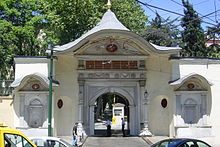- Ottoman Porte
-
For other uses, see Porte.
The Sublime Porte, also Ottoman Porte or High Porte (in Ottoman Turkish Bab-ı Ali in Albanian "Porta e Lartë" ), is a synecdoche for the central government of the Ottoman Empire, by reference to the High Gate of the Divan (court) of the Topkapı Palace in Istanbul.
The particular term was used in the context of diplomacy by Western states, as their diplomats were received at the porte (meaning gate). During the constitution period (see Young Turk Revolution), the functions of the Divan were replaced by the imperial government, and "porte" came to refer to the Foreign Ministry. During this period, Grand vizier came to refer to the position of a Prime Minister and viziers became the Ottoman Senate.
The Sublime Porte was the name of the open court of the sultan, led by the Grand Vizier. It got its name from the gate to the headquarters of the Grand Vizier in Topkapı Palace in Istanbul, where the sultan held the greeting ceremony for foreign ambassadors. It was an ancient Ottoman practice to make the gates of cities and kings' palaces places of assembly.
Later the name came to refer to the Foreign Ministry. In contemporary times, it is used for the office of the governor (Vali) of Istanbul Province. This name has also been interpreted as referring to the Empire's position as gateway between Europe and Asia.
The High Porte, in contrast, referred to the private court of the sultan. Porte is French for "gate"; therefore, the term High Porte is a bilingual combination of English High and French Porte, that is equivalent to Bab-ı Ali.
State organisation of the Ottoman Empire Central System
(Military administration)Government:Classic Period
Divan (Porte)Grand Vizier (list) · Viziers · Finance
Provincial System
(Civil administration)CentralMillets (Muslims (Sheikh ul-Islam) · Christians (Orthodox Patriarch · Armenian Patriarch · Syriac Orthodox) · Jews)LocalCategories:- Government of the Ottoman Empire
- Governors of Istanbul
- Gates
Wikimedia Foundation. 2010.


